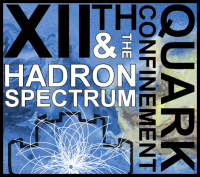Conveners
Section A: Focus Subsection
- Vladimir Shevchenko (National Research Centre Kurchatov Institute (RU))
Section A: Focus Subsection
- Thomas Schaefer (North Carolina State University)
We study the relation between quark confinement and chiral symmetry breaking in QCD.
First, we analytically derive some relations of the Polyakov loop or its fluctuations with Dirac eigenmodes for Wilson, clover and Domain-Wall fermions in QCD [1-3]. For these quantities related to confinement, the contribution from the low-lying Dirac eigenmodes is found to be negligibly small, while the...
The chiral magnetic effect (CME) is the generation of electrical current induced by chirality imbalance in the presence of magnetic field. It is a macroscopic manifestation of the quantum chiral anomaly in systems possessing charged chiral fermions. In quark-gluon plasma containing nearly massless quarks, the chirality imbalance is sourced by the topological transitions. In condensed matter...
The study of lattice gauge theories with Monte Carlo simulations is hindered by the infamous sign problem that appears under certain circumstances, in particular at non-zero chemical potential. So far, there is no universal method to overcome this problem. However, recent years brought a new class of non-perturbative Hamiltonian techniques named tensor networks, where the sign problem is...
The protein folding problem, it has been claimed, is one of the
most important problems in science; Dirac stated that the problem
of life is one in theoretical physics. We argue that gauge invariance
can be employed, to develop an energy function that describes the dynamics
of a folding protein, with sub-atomic precision.
We present a new Higgsless model of superconductivity, inspired from anyon superconductivity but P- and T-invariant and generalizable to any dimension. While the original anyon superconductivity mechanism was based on incompressible quantum Hall fluids as average field states, our mechanism involves topological insulators as average field states. In D space dimensions it involves a (D-1)-form...
I will discuss the phenomenon of quark liberation on domain walls in gauge theories which are confining in the bulk. Specifically I will discuss confinement-preserving compactifications of such theories. These are confining due to the magnetic bion mechanism. I will show that liberation on domain walls becomes natural in such theories. I will also discuss the spin-1/2 or “spinon” confinement...
We consider a quantum annealing simulation optimized for lattice QCD, reflecting the nonlinear network topology of the Kuramoto model where all the oscillators are considered to have distinct intrinsic natural frequency and a coupling scheme in which the optimum weight of a link to neighboring sites depends on the number of shortest paths crossing it. The onset of synchronization relies on...
The gauge field theory approach, which allows a natural way to introduce collective degrees of freedom and nonlinear topological structures based on fundamental principles of gauge symmetry is considered. This approach use description of the local geometry of proteins based on the formalism of discrete coordinates of Freney. Under this formalism, proteins are considered as one-dimensional...
